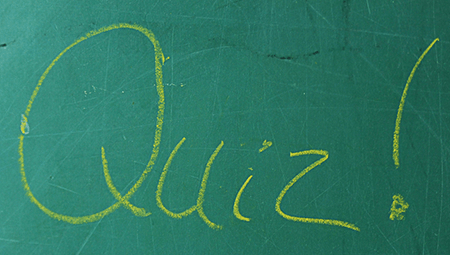Academic Integrity
An Important Issue in Anatomy & Physiology Courses
How do you prevent cheating in your A&P class?
Or do you even think about it?
Here, I explore a few general ideas and strategies addressing this important issue.
A Look at Cheating
One of my favorite “teaching” books is What the Best College Teachers Do. After examining diverse “master teachers,” the author (Ken Bain
) lists some of the characteristics most often seen in such individuals. One of them is that master teachers do not fret much about cheating in their courses. Instead, they seem to focus more on developing a culture in each learning community that naturally discourages dishonesty by building trust and integrity.
That revelation changed the way I look at cheating in my courses. Rather than working hard at developing complex anti-cheating strategies, I work hard at educating my students about the value of academic integrity. Although one can never be absolutely certain of the extent of cheating in one’s courses, the tools I do have available tell me that cheating is not a significant problem in my courses.
Of course, I do pay attention to setting things up in ways that discourage cheating, but I don’t go overboard . . . and I don’t worry about it.
How, exactly, do I promote academic integrity? And what are some of the specific methods that I use to discourage cheating? How do I know these strategies work?
Promoting Honesty
Building a culture of trust and professionalism require, at its core, an appropriate attitude and demeanor of the instructor. If I project an expectaction of professional integrity and model integrity myself, that will go a long way to build a culture of honesty.
I must also actively promote such a culture by:
- Including a clear statement of my expectations about academic integrity in my syllabus (available below).
- Verbally explaining the importance of honesty as part of the course introduction. I’ve provided some PowerPoint-compatible slides below.
- Facilitating student discussion of academic integrity in the classroom, using specific examples of acceptable and nonacceptable behavior as illustrations of ethical behavior. This strategy also allows students to see that honesty is valued by their peers. I’ve included the materials I use for this below.
- Looking for opportunities at various points in the course to commend honest behavior.
- Reminding students of the value of professional ethics.
After the students have their first online test in my course, they complain about its level of difficulty. I welcome this opportunity to explain how important it is to know the structure and function of the body thoroughly. I tell them that our common nightmare as A&P professors is that someday we’ll wake from an unconscious state in an ER and see a former student standing over us saying, “don’t worry Dr. Patton, after failing your course I paid for an easy correspondence course and now I’m here to take care of you!” In my nightmares, I’m usually restrained to a gurney and have a respirator tube in my throat, preventing me from screaming out, “NO! Get me a different nurse/physician/tech!” This is also a great opportunity to ask your students whether they want a cheater taking of them or their loved ones!

Free Resources
This is a brief article I posted in The A&P Student blog. It explains to students how it is to their advantage to be honest in the A&P course.
Kevin’s Academic Integrity statement
This is a statement I have used in my course syllabi. You are welcome to adapt it according to your own course and institution’s needs. It’s an example to get you thinking about actively promoting honesty.
Kevin’s PowerPoint slides on academic integrity
To access these FREE slides, you must download them from the Lion Den Slide Collection.
Kevin’ Academic Integrity Case Study handout/activity
This document is an example of an in-class activity that I use to promote discussion of academic integrity. It’s a handout used for small group discussions. You can adapt it to fit your needs (per the attribution/share-alike license enclosed in the document).
Discouraging Dishonesty
When I first began teaching, I assumed that the beginning and end of managing cheating was an elaborate set of countermeasures. I thought that maybe anti-terrorist training might be helpful, given all the sophisticated methods devised by students to cheat.
However, I now realize that creating an honest culture is far more effective at curbing academic dishonesty. Even so, some reasonablecountermeasures are also helpful.
In-class tests and quizzes
For in-class tests and assignments, I find that using more than one version of the test or quiz works well. All of my tests are created in a program called Respondus that allows me to instantly generate several different versions of a test (and key). There are other test editor programs out there that do the same thing. So it’s not really much trouble to start with this strategy.
I also often allow students to bring a help sheet to a test. Not only does this negate the need for a “cheat sheet,” it also gets students to review and summarize their knowledge as they produce their help sheet. I’m careful to never call it a “cheat” sheet because we’re not “cheaters” in our class, are we?
Of course, plain old vigilance during a test is always effective, right? Consider every object a possible source of illicit information:
- clothing, especially caps with bills
- cell phones and other mobile devices
- cups and other objects on the table
- pens and pencils
Online tests and quizzes
For online tests, quizzes, and other assignments, I’ve found that randomized testing is very helpful. This means that each student (and each attempt if more than one is allowed) is different than all other versions of the test. It takes a little while to set it up, certainly, but it’s well worth the time and effort.
Ask your LMS administrator or instructional design specialist about features built into your LMS that could help monitor cheating or prevent it. For example, I once caught a cheater on the online test by using the time-stamp feature for each response. She had a friend answer some items while she was in the classroom with me!
Some professors like to limit the time frame allowed for each online test or quiz, in the hope that they won’t have time to look up answers or get other help. My online tests are “open book” so I don’t use this method. However, I think time limits can cause more harm than good. Maybe they do limit cheating (although I doubt it). But they certainly make the course less inclusive by penalizing students that simply need more time to perform well. If I were taking a test in a second language, or if I struggled with dyslexia or other challenge, I would consider timing a test to be an unreasonable obstacle.
A similar strategy is to have your LMS display one question at a time. This makes it less likely that a student will print out the entire test then run to their book and quickly look up the answer.
Papers and reports
For reports and papers, there are web-based plagierism-detection services such as Turnitin that will check a student’s paper against a huge database of other papers and publications. These (and other services such as GPTzero) may also analyze content to see if it was created by an AI bot. Some schools have integrated one or more of these services into their LMS platform. Telling your students ahead of time about this service probably works better than sneakily “catching” them after the fact. Why? Because it tells them how valuable honesty is to you.
Be aware of a technique some students use to get around anti-plagiarism programs called Rogeting. Pronounced roh-ZHAY-ing, it’s named after the Roget of thesaurus fame. It involves substituting all the adjectives in a copied paper, so that the content retains its meaning but there is enough change to possibly avoid detection by automatic systems. You can often spot Rogeting when you grade, however, because it usually just reads weird—the narrative does not flow organically. But who knows, maybe sometimes Rogeting gets past the instructor.
Another strategy is to assign topics that are somewhat unique and not something easily copied from existing sources. Extending this idea, it’s a good idea to change topics frequently so that there’s not a library of student papers out there on your “unique” assignment.
If you have a passage that is suspect, you can “Google” it and see if the source can be found. Likewise, keep all papers until the whole group has been graded, so that you can check for copying when you run across similar passages in other papers.
Enforcement and other strategies
Before you do anything, check your school’s policies and procedures. You’ll want to make sure that what you are doing meshes with your school’s approach. And you want to be on solid legal footing if something bad happens and you really do catch some cheaters. You may also find that there are local campus resources to help you promote honesty and curb cheating.
When you do find dishonesty in your course, then act . . . do NOT ignore it and hope it doesn’t happen again. You always have a choice as to if you want to escalate the incident to a vigorous response. But you must respond somehow. If you don’t, then the individual(s) involved will see the way clear to repeat and expand their dishonest activity . . . a ticking time bomb. Likewise, looking the other way will also send a general message to students that you are willing to overlook dishonesty.
Someday, one of YOUR students may be providing health care for me or my family . . . and I don’t want you letting any cheaters out there to cause harm!
One last strategy: tell students that you have methods of detection that you won’t reveal to them. That way, they know you intend to be vigilant . . . and they won’t be quite sure what super-advanced methods you might have up your sleeve. Is doing this dishonest? Nope; your “secret” methods could be as simple as watching them carefully during a test. Just hold back SOME anti-cheating method and your statement will be an honest one.
Does this really work?
How do I know that these strategies work? Because I am vigilant and have found that my observations of dishonesty have sharply dropped after I began actively promoting a culture of honesty and respect. In addition, anonymous surveys of many hundreds of students after finishing my course also reveal a drop in cheating.
Of course, I have no way to be absolutely sure of the cheating trends in my course. But I’m confident that focusing more on developing integrity than on catching cheaters is a worthy approach to college teaching.
Listen Now
Here’s a brief audio segment on academic integrity in the A&P course from The A&P Professor podcast (starts at the correct segment). Click here for the show notes with links.
Here’s a reprise of the briefer segment (above) along with new content that specifically addresses remote teaching. Click here for the show notes with links.
Last updated: July 6, 2023 at 12:46 pm
🏅 NOTE: TAPP ed badges and certificates can be claimed until the end of 2025. After that, they remain valid, but no additional credentials can be claimed. This results from the free tier of Canvas Credentials shutting down (and lowest paid tier is far, far away from a cost-effective rate for our level of usage). For more information, visit TAPP ed at theAPprofessor.org/education



